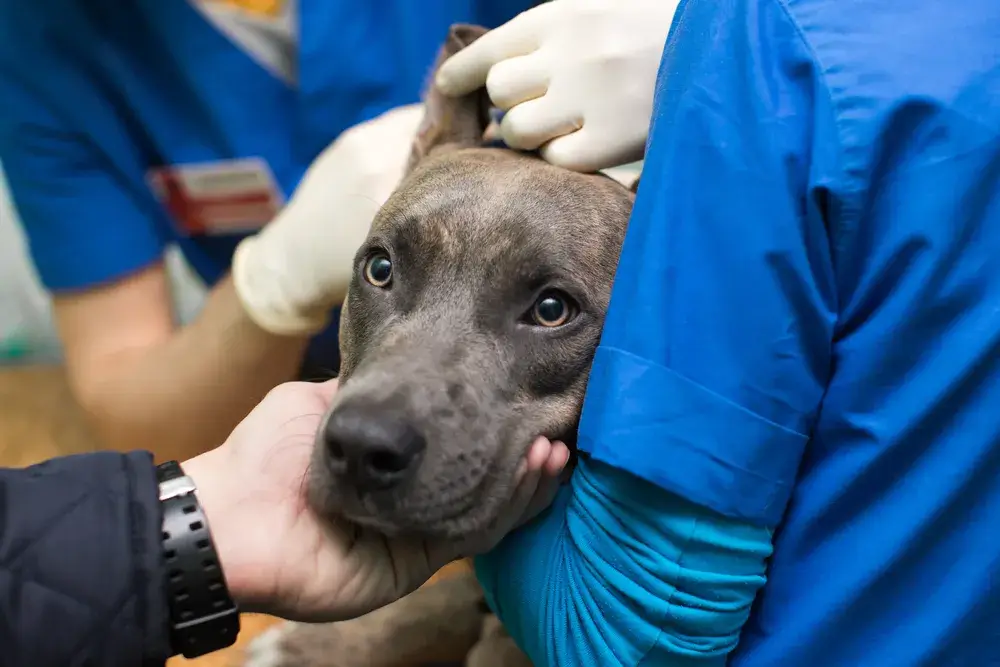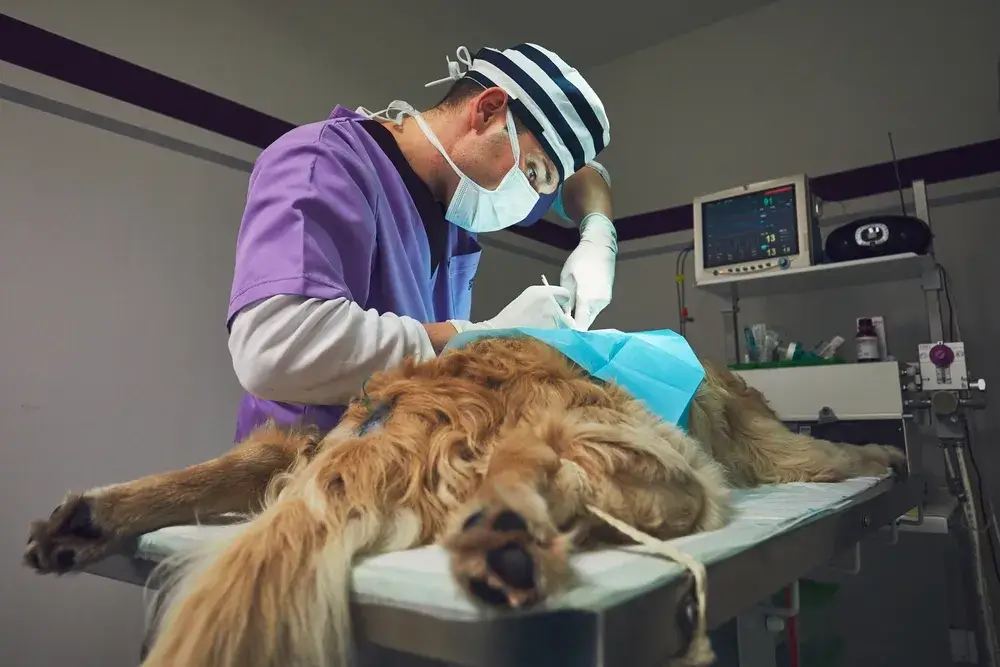Having a dog is a big responsibility. Not only do you have to make sure your dog is properly fed, but you also have to ensure he receives proper medical care. Even with the best intentions, sometimes accidents happen, and our pets need surgery.
Unfortunately, not all pet owners can afford to provide their furry friends with the medical attention they need, which can lead to some costly surgeries.
The cost of dog surgery can be prohibitive, especially if your dog needs multiple surgeries. It’s important to be aware of the most expensive canine surgeries, so you can be prepared financially if your dog ever needs one of them. Here are 5 of the most expensive canine surgeries.
1. Total Hip Replacement Surgery – $3,500 to $7,000
What is Total Hip Replacement Surgery?
A total hip replacement (THR) for dogs is surgery that replaces the dog’s hip joint with an artificial joint to relieve pain and improve mobility. Because of the complications involved it is one of the most expensive canine surgeries around the globe.
This surgery is most commonly performed on dogs that have hip dysplasia, a condition that causes the hip joint to form improperly. This leads to the ball and socket grinding against each other and causes severe pain, lameness, and loss of function. Other indications for this surgery include the following:
- Severe arthritis of the hip joint
- Fracture of the hip joint
- Severe hip dislocation
- Severe pain that does not respond to other forms of treatment
How Total Hip Replacement Surgery is Done?
The THR surgery is typically done under general anesthesia. The surgery is performed through a relatively small incision directly over the hip of the dog and involves the following steps:
- The diseased or damaged hip joint is removed. A metal stem is inserted into the femur (thighbone).
- A metal ball is then attached to the top of the stem.
- A plastic socket is inserted into the pelvis.
- The metal ball fits snugly into this socket, completing the new “artificial hip joint.”
This new “artificial hip joint” replaces the dog’s damaged natural hip joint.
What Risks are Involved in Total Hip Replacement Surgery?
THR surgery for dogs has a high success rate, with excellent limb function in over 90% of cases. However, the most common complication is luxation (dislocation) of the prosthesis, while other less common complications are loosening of the prosthesis, fracture of the femur, and infection.
What is the Cost Involved?
A hip replacement surgery can cost from $3,500 to $7,000 for a single hip and that the main reason for it being one of the the most expensive canine surgeries. The cost will depend on the severity of your dog’s condition, the type of material used, and post-operative care.

2. Tibial Plateau Leveling Osteotomy (TPLO): $3,500 – $5,000
What is TPLO Surgery?
The main purpose of TPLO surgery is to correct cranial cruciate ligament rupture (CCL), which is a common problem in dogs. CCL rupture can cause persistent lameness and instability in the stifle joint, which can lead to further damage over time.
TPLO surgery is needed to restore stability to the knee and improve the dog’s quality of life. It is one of the the most expensive canine surgeries that improve the overall life quality of a dog.
How TPLO Surgery is Done?
The TPLO procedure involves the inspection of knee joints by making a small incision on the top of the knee. Many dogs with this type of rupture may also have torn cartilage (menisci). If damaged portions are found, they need to be removed and any remnants of the ruptured ligament trimmed.
The tibial plateau may be leveled by either cutting the tibia with a curved saw and rotating the plateau or by removing a wedge of bone from the front of the tibia and closing the gap with the aid of a loop of wire. In the end, specially designed plates are applied to cut the bone and then fixed by screw.
These changes address the dynamic movement between bones in the knee, which is lost when CCL is damaged.
What Risks are Involved in TPLO Surgery?
The risks involved in TPLO surgery are similar to those of any other type of orthopedic surgery. Bleeding, swelling, bruising, screw loosing, and persistent lameness are the most common complications.
Additionally, as the tibia is cut and rotated during this surgery, there is a risk that the bone may not heal properly, which could lead to further complications.
What is the Cost Involved?
The cost of TPLO surgery can range from $3,000 to $4,000 for one knee. This usually includes X-rays, blood work prior to the surgery, anesthesia, pain medication during and after the operation, post-surgery care, as well as follow-up medications.
3. Gastropexy $1000-$6000
What is Gastropexy?
Gastropexy is a procedure that is used to prevent the condition known as bloat or gastric dilation volvulus (GD) from occurring in dogs. Bloat is a potentially life-threatening condition that occurs when the stomach twists on itself, cutting off the blood supply and trapping gas inside.
This is typically performed on dogs that are at high risk for gastric torsions, such as deep-chested breeds.
How Gastropexy is Done?
Although there are many different gastropexy procedures, incisional gastropexy is the most recommended because it’s easy to do and has low complication rates compared to other techniques.
It may be performed under general anesthesia with a large abdominal incision or by laparoscopic techniques, which require significantly smaller incisions. After examining the stomach for necrosis, it is attached to the abdominal wall, so it prevents the stomach from twisting out of its normal position in the future.
What Risks are Involved in Gastropexy?
While gastropexy is a relatively common and safe surgery, there are some risks involved. The most common complication is that the stomach may become adherent to the surrounding organs, which can require further surgery to correct.
Other risks include:
- Infection
- Bleeding
- Damage to surrounding organs
- Suture opening due to dog movement and jumping
- Anesthetic complications
What is the Total Cost Involved?
The price of gastropexy surgery can change based on the complexity of the procedure and the average cost range from $1,000 to $6,000.

4. Gastrointestinal Tract Surgery – $2,000 to $10,000
What is Gastrointestinal Tract Surgery?
Gastrointestinal surgery is performed to treat various gastrointestinal problems in dogs, such as the removal of a foreign body, stomach ulcers, upper gastrointestinal bleeding, resection of the stomach or intestine, and for neoplasia.
If the dog ingests something it cannot digest, it may need to be removed through surgery. This is because if an indigestible object gets stuck in the intestines, an obstruction will occur.
Obstructions cause fluid loss, bowel dysfunction, dehydration, and lack of oxygen to the bowels. Some of the most common objects are pieces of toys, rocks, bones, plastic, or cloth.
If this happens and surgery is required, it is often the only option to remove the obstruction and save the dog’s life.
How GIT Surgery is Done?
The surgery will be performed under general anesthesia. A small incision will be made in the abdomen, and the foreign body will be removed. If the foreign body has caused any damage to the intestines, it may need to be repaired. The incision will then be closed and the dog will be placed in a recovery kennel.
What Risks are Involved in GIT Surgery?
The main risks associated with gastrointestinal surgery are the complications of anesthesia and abdominal bleeding. In addition, any incisions in the intestines can lead to infection, abscesses, or bowel dysfunction. Other possible complications include failure of suture material, intestinal rupture, and anastomotic leakages.
What is the Total Cost Involved?
The cost of gastrointestinal surgery can vary depending on the severity of the problem and how long the surgery takes. However, the average cost is anywhere from $200 to $10000.
5. Intervertebral Disc Surgery – $1,500 to $5,000
What is Intervertebral Disc Surgery?
Intervertebral disk disease (IVDD) is a condition that can occur in the dog’s neck or back, and it often results in a ruptured, slipped, bulging, or herniated disk. This condition is most common in beagles, dachshunds, Pekingese, Shih Tzus, and basset hounds, but any size or breed of dog may be affected.
The most common symptom of IVDD is a sudden onset of paralysis in the hind legs, uncoordinated movement, neck and back pain, unable to lift the head up, etc.
How Intervertebral Disk Surgery is Done?
The goal of surgery is to relieve the pressure on the spinal cord or nerves and allow the dog to regain the use of its legs. Many types of IVDD surgery exist, such as fenestration, hemilaminectomy, laminectomy, and ventral slot. The type of surgery the dog will need depends on the location and severity of the disk problem.
The most common type of surgery is a partial or complete removal of the affected disk (discectomy). In some cases, the surgeon may also need to fuse the vertebrae together (spondylodesis).
What Risks are Involved in Intervertebral Disk Surgery?
The most common complication after surgery is incontinence, which affects about 20% of dogs. Other potential complications include infection, nerve damage, and spinal cord damage.
What is the Cost Involved?
The average cost of IVDD surgery ranges from $1,500 to $5,000, depending on the type of surgery and the severity of the dog’s condition as well as various laboratory tests.

Conclusion
No one wants to think about the possibility of their dog needing surgery, but it’s important to be aware of the most expensive surgeries in case it happens. By being prepared financially, you can ensure that your dog receives the best possible care.
Frequently Asked Questions
What are the most expensive canine surgeries for a dog?
The most expensive surgeries for a dog is hip replacement and TPLO, which can cost between $3,500 and $7,000. Other costly surgeries include hip dysplasia repairs, bladder stone removal, and cancer treatments.
How can I afford to pay for my dog’s surgery?
There are a few options available to help cover the cost of your dog’s surgery. Many pet insurance policies will cover at least a portion of the costs, and there are also a number of financing options available from veterinary hospitals and clinics.
You can also look into fundraising options such as online crowdfunding platforms or donation-based websites.
Why is dog surgery so expensive?
The cost of dog surgery can be expensive because it often requires specialized equipment and trained personnel. In addition, the cost of anesthesia and post-operative care can add up quickly.
How much does a vet charge to remove a tumor?
The cost of surgery for a dog tumor can vary depending on the size and location of the tumor, as well as the type of surgery required. Tumor removal surgery can cost anywhere from $500 to $5,000.
How much does it cost to have a fatty tumor removed from a dog?
The cost of surgery to remove a fatty tumor from a dog can range from $500 to $2,000. The exact cost will depend on the size and location of the tumor, as well as the type of surgery required.
What is the most common surgery for dogs?
The most common surgery for dogs is spaying or neutering. This surgery is typically done to help control the pet population, but it can also have health benefits for your dog.
Should I put my senior dog through surgery?
The decision to put your senior dog through surgery should be made on a case-by-case basis by you and your veterinarian. Your veterinarian can help you weigh the risks and benefits of the surgery and help you make the best decision for your pet.



